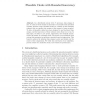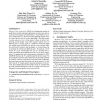2084 search results - page 80 / 417 » Proving Time Bounds for Randomized Distributed Algorithms |
ISORC
2005
IEEE
15 years 3 months ago
2005
IEEE
Heuristic algorithms have enjoyed increasing interests and success in the context of Utility Accrual (UA) scheduling. However, few analytical results, such as bounds on task-level...
CORR
2007
Springer
14 years 9 months ago
2007
Springer
— We are given an equal number of mobile robotic agents, and distinct target locations. Each agent has simple integrator dynamics, a limited communication range, and knowledge of...
STOC
1996
ACM
15 years 1 months ago
1996
ACM
We significantly improve known time bounds for solving the minimum cut problem on undirected graphs. We use a "semiduality" between minimum cuts and maximum spanning tree...
WDAG
2005
Springer
15 years 3 months ago
2005
Springer
In a distributed system with N processes, time stamps of size N (such as vector clocks) are necessary to accurately track potential causality between events. Plausible clocks are a...
SIGMOD
2010
ACM
15 years 2 months ago
2010
ACM
Maximal clique enumeration (MCE) is a fundamental problem in graph theory and has important applications in many areas such as social network analysis and bioinformatics. The prob...


